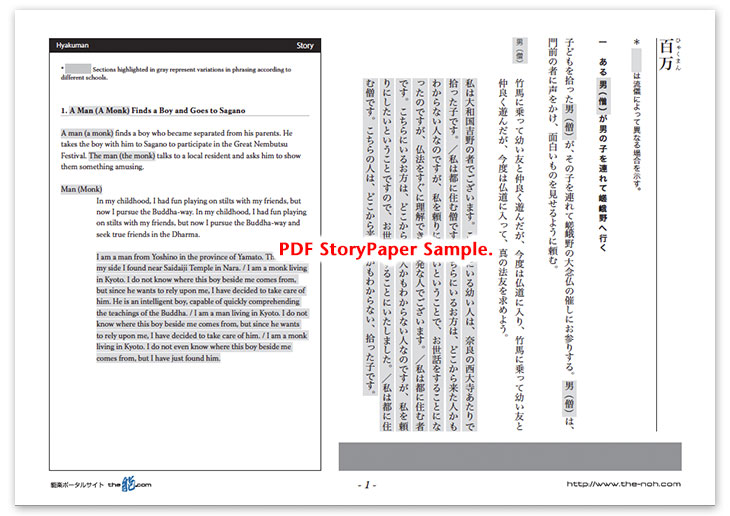
 Hyakuman
Hyakuman

![]()
One spring, a man (in some versions, a monk) finds a boy and brings him to a temple in Sagano, Kyoto, where they participate in the Great Nembutsu Festival. Then, a madwoman named Hyakuman arrives at the temple. She insists that their way of chanting the nembutsu (an invocation of the Buddha) is not right. In order to make an example for them, she starts to lead the recitation. Then, Hyakuman reveals that she has lost her mind because she and her child became separated. Having gone mad, she prays that the Buddha will reunite her with the her child.
The boy, who has been watching the woman for a while, realizes that she is his mother. He asks the man caring for him (the monk) to indirectly inquire of her about her son. The man (the monk) asks Hyakuman where she is from and how she lost her sanity. Hyakuman replies that she is from Nara and that she lost her husband and became separated from her only child. She further mentions that in public, she intentionally acts mad in order to find her son and be reunited with him. She then performs a variety of dances.
Seeing the heartbroken mother, the man (the monk) is deeply moved and brings Hyakuman and the boy together. Hyakuman is overjoyed. Mother and son express their gratitude for the merits of the Buddha’s teachings and they return to Nara together.
![]()
“Hyakuman” is a masterpiece of Madwoman Noh dramas, which describe mothers who have been separated from their children. This popular play is frequently performed. Zeami revised “Saga-monogurui (Mad Person in Saga),” which was originally written by Kannami, to create “Hyakuman.” According to legend, the lead character, Hyakuman, (whose name serves as the title of this piece), was a kusemai dancer (a dancing storyteller) who actually existed in history.
The setting of this play, Seiryōji Temple in Sagano, was built at the location where Minamoto no Tōru’s mountain villa used to be. Seikaji Temple existed there before Seiryōji Temple. Monk Chōnen, who underwent training in China during the Song dynasty (1127-1279), intended to build the temple in order to enshrine a copy of a statue of Shakyamuni Buddha that, according to legend, was created in India during the lifetime of Shakyamuni Buddha. His disciples built Seiryōji Temple within the precincts of Seikaji Temple to realize their master’s wishes. During the Kamakura era (1185-1333), Yūzū Nembutsu flourished in Seiryō-ji Temple and eventually the temple started to host the Great Nembutsu Festival. One legend explains that Saint Engaku, said to be the founder of Great Nembutsu (that is, Yūzū Nembutsu), was reunited with his mother by the dharmic power of Shakyamuni Buddha. Today, the Saga Dai-nembutsu Kyōgen, which began as a way of disseminating nembutsu invocation, is still practiced a few times a year.
The story of “Hyakuman” developed against such a background, and although the theme of this piece is the dramatic reunion of a mother and a son who have been separated, it also features a number of dances performed by a skilled dancer, Hyakuman. Therefore, it is quite entertaining. After the scene in which Hyakuman appears and recites the nembutsu invocation, this piece offers a series of interesting chants and great dance performances, continuing as [kuruma-no-dan], [sasa-no-dan], [iroe], [kuse], and [tachimawari / kakeri / iroe].
Enjoy the chanting and dances performed in the scene in spring Sagano, ornamented by cherry blossoms.
STORY PAPER : Hyakuman
Story Paper presents noh chant stories in modern speech, with story outlines, highlights and more using Adobe PDF format, which can print out and zoom in. Print out the pages and take them with you when you see the actual noh performance.

The copyright of Story Paper is held by the Noh.com. Story Paper is for individual use only. It is prohibited by the copyright law to distribute or publish printed-out Story Paper pages without prior consent. For more information, check the credit and disclaimer pages.



 [Hyakuman : Story Paper PDF : 536KB
[Hyakuman : Story Paper PDF : 536KB